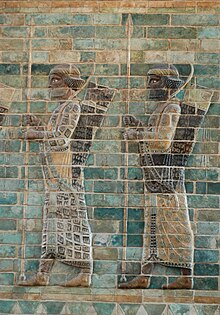Palace of Darius I (Susa)
The palace of Darius I in Susa is one of the most important buildings of the Achaemenid Empire and probably served as a model for other palace buildings.
Darius I expanded Susa into one of the four residences of his empire and therefore also built a huge palace in the north of the city, in the part of the city called Apadana by the excavators. An artificial terrace was built for this purpose. This was about 18 meters high at the highest point and took up an area of about 13 hectares.
The ruler's inscription tells of the building of the palace. Accordingly, the soil was dug out to the grown earth and filled with gravel. The walls of the palace were made of clay. Wood was brought in from Lebanon , Gandhara and Kirman . Gold came from Lydia and Bactria , other precious materials from different parts of the empire, while the stone pillars were broken in Elam. Egyptians, Medes , Lydians and Babylonians are named as craftsmen .
In the east stood the Proylaea, which is a pavilion with a floor plan of 24 × 24 meters. It consisted of several rooms and was decorated with columns on two sides. The building apparently had a ceremonial function.
A little to the west of it was a monumental gateway. It was 40 by 30 meters. The building had an inner hall with four pillars that were once around 12 to 13 meters high. A colossal statue of Darius was found at the entrance to the building. It is the only one of its kind in Achaemenid art. It was made for the temple in Heliopolis according to the inscription in Egypt and brought to Susa by Xerxes I. It bears Egyptian hieroglyphics and cuneiform texts.
The actual palace building excavated so far was over 246 × 155 meters in size and took up an area of about 5 hectares. The palace had at least three large, open courtyards. The largest of these measured 64 × 55 meters. It was probably decorated with a lion frieze on the north side. Other walls bore a frieze of archers.These friezes made of fired and painted bricks are now largely in the Louvre in Paris . In general, the building was richly decorated with relief and painted bricks. A middle courtyard of 36 × 33 meters followed. From here one could get to the apartments of high officials. The inner courtyard was 36 × 31 meters. Under each door there were boxes made of burnt clay containing foundation deposits. The ruler's private rooms were accessed from this court. Here building inscriptions were found in Elamite and Akkadian. A last yard was the center of the farm wing.
To the north was the great pillared hall known as Apadana . It took up an area of 109 × 109 meters and was thus slightly larger than the Apadana in Persepolis . The central room was 58 × 58 meters and was supported by six by six rows of columns. Each column weighed more than 25 tons. It had a capital with bull-headed protomes . It is not known how the walls of this hall were decorated. The palace is clearly in the Mesopotamian and Elamite tradition, especially with the use of adobe bricks as the main material. Parallels to palace buildings in Babylon and Nineveh can also be drawn in the plan . The portico, on the other hand, is Iranian. Comparable components are known from Iran.
According to an inscription, the palace burned down under Artaxerxes I , who however rebuilt and renovated it.
First excavations took place in 1851 by the British William Kennett Loftus. Further excavations followed in 1885 by M. and J. Dieulafoy, who mainly found the numerous tiles and brought them to Paris. Further research followed until the end of the twentieth century.
literature
- ML Pillet: Le palais de Darius Ier a Suse , Paris 1914
- J. Perrot, D. Ladiray: The palace of Susa , In: Land der Bibel , edited by W. Seipel, Vienna 1997, ISBN 3-900325-75-8 , pp. 170-185
- DT Potts: The Archeology of Elam , Cambridge University Press, Cambridge 1999, ISBN 0521563585 , pp. 325-335
Web links
Coordinates: 32 ° 11 ′ 28 " N , 48 ° 14 ′ 56" E



